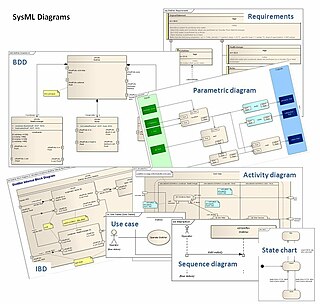
The Object Management Group (OMG) is a computer industry standards consortium. OMG Task Forces develop enterprise integration standards for a range of technologies.
The Open Group is a global consortium that seeks to "enable the achievement of business objectives" by developing "open, vendor-neutral technology standards and certifications." It has 900+ member organizations and provides a number of services, including strategy, management, innovation and research, standards, certification, and test development. It was established in 1996 when X/Open merged with the Open Software Foundation.
Model-driven architecture (MDA) is a software design approach for the development of software systems. It provides a set of guidelines for the structuring of specifications, which are expressed as models. Model Driven Architecture is a kind of domain engineering, and supports model-driven engineering of software systems. It was launched by the Object Management Group (OMG) in 2001.
The Data Distribution Service (DDS) for real-time systems is an Object Management Group (OMG) machine-to-machine standard that aims to enable dependable, high-performance, interoperable, real-time, scalable data exchanges using a publish–subscribe pattern.

Business Process Model and Notation (BPMN) is a graphical representation for specifying business processes in a business process model.

Unicom System Architect is an enterprise architecture tool that is used by the business and technology departments of corporations and government agencies to model their business operations and the systems, applications, and databases that support them. System Architect is used to build architectures using various frameworks including TOGAF, ArchiMate, DoDAF, MODAF, NAF and standard method notations such as sysML, UML, BPMN, and relational data modeling. System Architect is developed by UNICOM Systems, a division of UNICOM Global, a United States–based company.

An enterprise architecture framework defines how to create and use an enterprise architecture. An architecture framework provides principles and practices for creating and using the architecture description of a system. It structures architects' thinking by dividing the architecture description into domains, layers, or views, and offers models – typically matrices and diagrams – for documenting each view. This allows for making systemic design decisions on all the components of the system and making long-term decisions around new design requirements, sustainability, and support.
Model-driven engineering (MDE) is a software development methodology that focuses on creating and exploiting domain models, which are conceptual models of all the topics related to a specific problem. Hence, it highlights and aims at abstract representations of the knowledge and activities that govern a particular application domain, rather than the computing concepts.
The Unified Profile for DoDAF/MODAF (UPDM) is the product of an Object Management Group (OMG) initiative to develop a modeling standard that supports both the USA Department of Defense Architecture Framework (DoDAF) and the UK Ministry of Defence Architecture Framework (MODAF). The current UPDM - the Unified Profile for DoDAF and MODAF was based on earlier work with the same acronym and a slightly different name - the UML Profile for DoDAF and MODAF.

The systems modeling language (SysML) is a general-purpose modeling language for systems engineering applications. It supports the specification, analysis, design, verification and validation of a broad range of systems and systems-of-systems.
Modeling and Analysis of Real Time and Embedded systems also known as MARTE is the OMG standard for modeling real-time and embedded applications with UML2.

ArchiMate is an open and independent enterprise architecture modeling language to support the description, analysis and visualization of architecture within and across business domains in an unambiguous way.
Process map is a global-system process model that is used to outline the processes that make up the business system and how they interact with each other. Process map shows the processes as objects, which means it is a static and non-algorithmic view of the processes. It should be differentiated from a detailed process model, which shows a dynamic and algorithmic view of the processes, usually known as a process flow diagram. There are different notation standards that can be used for modelling process maps, but the most notable ones are TOGAF Event Diagram, Eriksson-Penker notation, and ARIS Value Added Chain.
Enterprise interoperability is the ability of an enterprise—a company or other large organization—to functionally link activities, such as product design, supply chains, manufacturing, in an efficient and competitive way.
SoaML is an open source specification project from the Object Management Group (OMG), describing a Unified Modeling Language (UML) profile and metamodel for the modeling and design of services within a service-oriented architecture.
This article provides a comparison of Business Process Model and Notation (BPMN) tools.
Sparx Systems is an Australian software company founded by Geoffrey Sparks in 1996 in Creswick, Victoria in Australia, known for the development of the Unified Modeling Language tool Enterprise Architect.
ADONIS is a Business Process Management (BPM) tool, used for documentation, analysis, and optimization of business processes. It enables the visualization of process flows and standard operating procedures (SOPs), provides visibility into how they operate, and helps increase their efficiency by revealing redundant efforts and opportunities for improvement.

Sparx Systems Enterprise Architect is a visual modeling and design tool based on the OMG UML. The platform supports: the design and construction of software systems; modeling business processes; and modeling industry based domains. It is used by businesses and organizations to not only model the architecture of their systems, but to process the implementation of these models across the full application development life-cycle.







